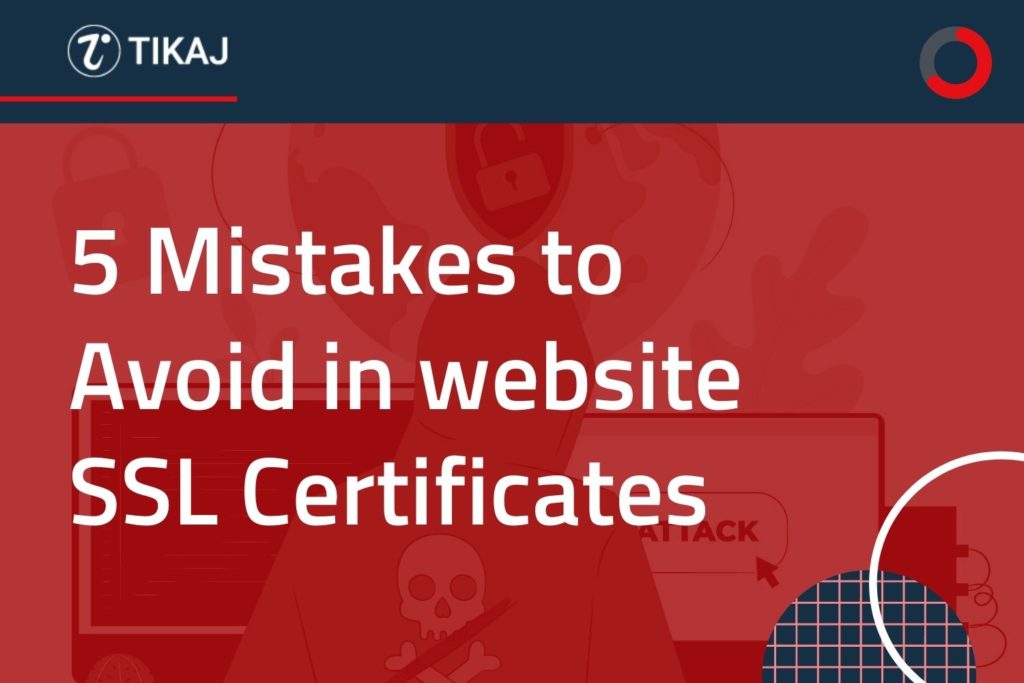SSL Certificates : 5 Mistakes to Avoid in Website

Table of Contents
What is an SSL Certificate?
SSL stands for Secure Sockets Layer, a global standard security technology that enables encrypted communication between a web browser and a web server. It is routinely used by millions of online organizations and individuals to reduce the danger that sensitive information (such as credit card numbers, usernames, passwords, emails, etc.) may be stolen or altered with by hackers and identity thieves.
In essence, SSL allows for a private “conversation” just between the two intended parties. This authentication process is much like sealing a letter in an envelope before sending it through the mail. SSL, short for Secure Sockets Layer, is commonly used on e-commerce sites and pages that require users to submit personal or credit card information.
Importance of SSL Certificate
An SSL certificate ensures that the provider is who they claim to be and also indicates secure

connections between personal devices and websites. Understanding SSL certificates is important for website trust and to help protect customers from becoming a victim to scammers.
It’s smart to keep in mind that not all websites, or SSL certificates, are created equal. In order to create this secure connection, an SSL certificate also referred to as a “digital certificate” which is installed on a web server that majorly serves two functions:
- It authenticates the identity of the website (this guarantees visitors that they’re not on a bogus site)
- It encrypts the data that’s being transmitted
An SSL certificate also helps in secure information such as:
- Login credentials
- Credit card transactions or bank account information
- Personally, identifiable information — such as full name, address, date of birth, or telephone number
- Proprietary information
- Legal documents and contracts
- Medical records
SSL Certificates are selling like hotcakes nowadays. As more and more websites become secure, the entire online landscape is changing right in front of our eyes.
SSL Certificate mistakes to avoid before buying & managing
Unfortunately, what appears to be a straightforward action can prove surprisingly complex and time-consuming for inexperienced users. No need to panic though, here are the 5 most common SSL mistakes to avoid when buying, installing, and managing your SSL Certificate.
1. Falling for the wrong SSL Certificate for your site
SSL Certificates have different forms and prices. One may defraud you by making you pay little in exchange to secure your website or spend thousands of bucks on a single certificate. The sheer choice can be overwhelming at first, but there’s no need to rush. Go through the entire list of SSL brands and analyze the specs and features of each product. More expensive isn’t always better for your particular project, just like cheap isn’t often good enough. You need to know exactly what type of SSL your website requires.
2. Server compatibility check is a must
When you feel that you’ve found the ideal SSL Certificate for your site, hold on there’s absolutely no need to buy it immediately. First, make sure you can install it on your website’s server. Every hosting provider has different in-house rules regarding SSL Certificates. This mainly concerns shared hosting plans, so if you’re on a VPS or dedicate server, you shouldn’t face any compatibility issues. Still, it’s always better to contact your hosting company and double-check with them.
3. Prepare for the validation process
The validation process is done via CSR (Certificate Signing Request) available on our site. You won’t be able to obtain your SSL Certificate unless you provide correct and up to date information about your domain/company to the Certificate Authority. If you need to validate your domain name, make sure you submit its exact name, without any typos. To validate an organization, you’ll have to provide additional company documentation. If you accidentally put some wrong information in the CSR, the Certificate Authority may decline your request. Pay close attention to this step, as it’s here users usually make the most common SSL mistakes.
4. Experience matters
If you’ve never installed an SSL before, and don’t have any experience in managing your hosting account, better leave this step to a seasoned developer. Although we offer step by step guides on how to install their products on a specific server, you don’t want to risk messing with your server configuration. A small mistake can lead to a big problem.
5. Ignoring calls for risks
Many users erroneously think that installing the certificate on the server is all it takes to activate the HTTPS and the padlock. However, the reality is different. You still have to go through a couple of important steps and add the finishing touches. Remember to test your installation for errors, and make the necessary SEO adjustments, for a proper HTTPS transition
8 common SSL/TLS certificate errors
If you have already purchases the certificate and it’s still not working correctly, there are several common errors that can occur when working with SSL/TLS certificates, which can cause problems for both the website and its visitors. In this section, we will discuss eight of the most common SSL/TLS certificate errors, including expired certificates, self-signed certificates, certificate mismatches, and more. Understanding these errors can help website administrators and developers troubleshoot issues and ensure that their websites are secure and trustworthy.
- Incorrect Domain Name: This error occurs when the domain name specified in the certificate signing request (CSR) does not match the actual domain name of the website.
- Incorrect Company Name: This error occurs when the company name specified in the CSR does not match the actual company name.
- Incorrect Contact Information: This error occurs when the contact information specified in the CSR is incorrect or incomplete.
- Key Pair Mismatch: This error occurs when the private key and the public key do not match, which can happen if the keys were generated separately or if the private key was lost or compromised.
- CSR Generation Error: This error occurs when there is a problem generating the CSR, often due to a technical issue or a formatting error.
- Private Key Not Protected: This error occurs when the private key is not properly protected, such as not being encrypted or not being stored in a secure location.
- Incorrect Signature Algorithm: This error occurs when the wrong signature algorithm is used to sign the CSR, which can cause compatibility issues with certain servers or browsers.
- CSR Not Submitted to CA: This error occurs when the CSR is not submitted to the certificate authority (CA) for signing, which is required in order to obtain an SSL certificate.
You can find infographics of common SSL Certificate issues here.
Conclusion
In conclusion, SSL/TLS certificates play a crucial role in the security and trustworthiness of a website. However, there are several common errors and mistakes that can occur when working with these certificates, including expired certificates, self-signed certificates, certificate mismatches, and more. It is important for website administrators and developers to be aware of these errors and to take steps to avoid them. This can help ensure that their websites are secure and trustworthy for their visitors, and can help prevent problems such as security vulnerabilities or loss of credibility.
By following best practices and being vigilant about certificate management, website administrators can ensure that their SSL/TLS certificates are working properly and that their websites are secure and trustworthy.
You can use our cyber security consultation service for further help.






